Table of Contents
ToggleWhere we Test
All of our tests when it comes to hiking shoes (and all gear in general) happen outdoors, in the same places you will experience them. All of us at This Expansive Adventure are avid hikers, live and breathe the outdoors and get excited (geeky) about testing gear to the limit.
We want you to feel safe when you buy through one of our recommendations and trust that the information we’re giving you is correct. Of course, our reviews and tests are based on our opinions, but we’ve clocked a lot of miles to give you our round up of the best hiking shoes out there for all budgets and preferences.
Editor’s note: This article is part of our guide to the best hiking shoes, be sure to check out the rest of this guide for our top buying tips:
Testing Metrics
As with all our reviews, we go through a full-on testing process outdoors. We test in a huge variety of different weathers and conditions to make sure everything is up to scratch before we make our recommendations. There are a range of areas that are particularly important to us in the testing process though, and these can be categorized as the following.
Type and Style
With every hiking shoe we review, we take into consideration the type of shoe it is and what it is intended for. Some shoes are more intended for fast packing and are a kind of trail runner hybrid. These are obviously lighter, often more flexible than a traditional, often ‘harder’ hiking shoe. It is important to us that we don’t just pass off one shoe because it is intended for something else and instead, we look at the whole piece holistically.
Not everybody wants a hiking shoe for the same purpose exactly, so it’s important for us that we don’t ‘rank things down’ by not fully looking at their intended purpose.
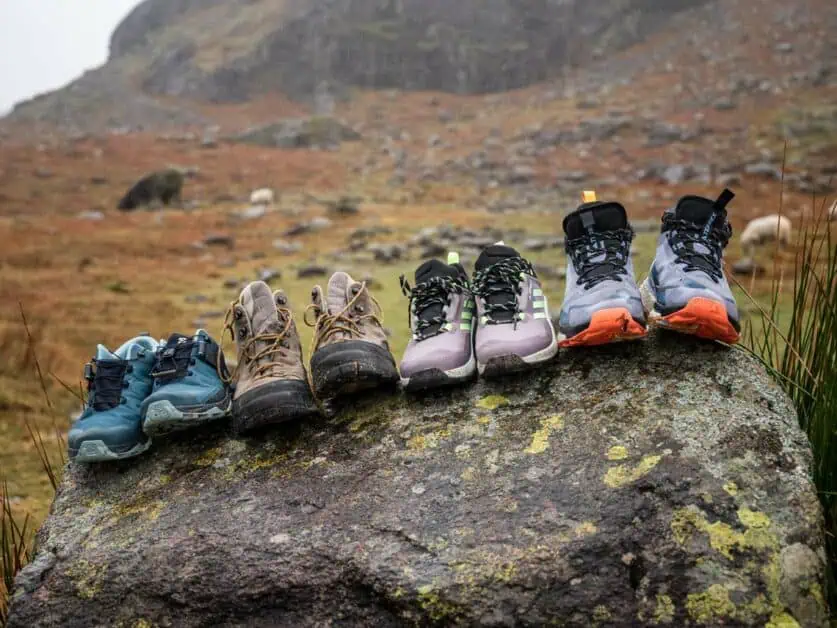
Price
We believe price can be one of the biggest barriers to the outdoors for a lot of people. If you’ve been in the scene for quite a while, you’ll likely be in a position where you’re looking to upgrade to something better than your previous version. That doesn’t mean you have an endless budget though!
Likewise, if you are just starting out, you might not know where you want to go with your adventures and be reluctant (or not have the funds) to spend on something that could be pretty expensive, and an investment. You want to know you’re going to get plenty of use out of something before you go ahead and buy.
In our reviews, we’ve recommended a whole range of price points, and you’ll typically see a wide range of prices for products offered. When testing, we take into consideration the price point versus what you’re actually getting for that – and some brands provide a hiking shoe that punches well above its weight in terms of price.
Traction
Traction is one of the most important areas for us when it comes to testing the hiking shoes, we’ve recommended to you. Traction can vary massively from shoe to shoe so we always look at what a shoe’s best use would be when testing. Some shoes are better suited to slippery, rocky terrain whereas others are more suited to sand, desert etc. and some more slick rock or alpine surfaces.
As above, we look at this holistically, and offer our opinions taking into consideration what the shoe is intended for – which makes it easier for you to make the right decision for your needs.
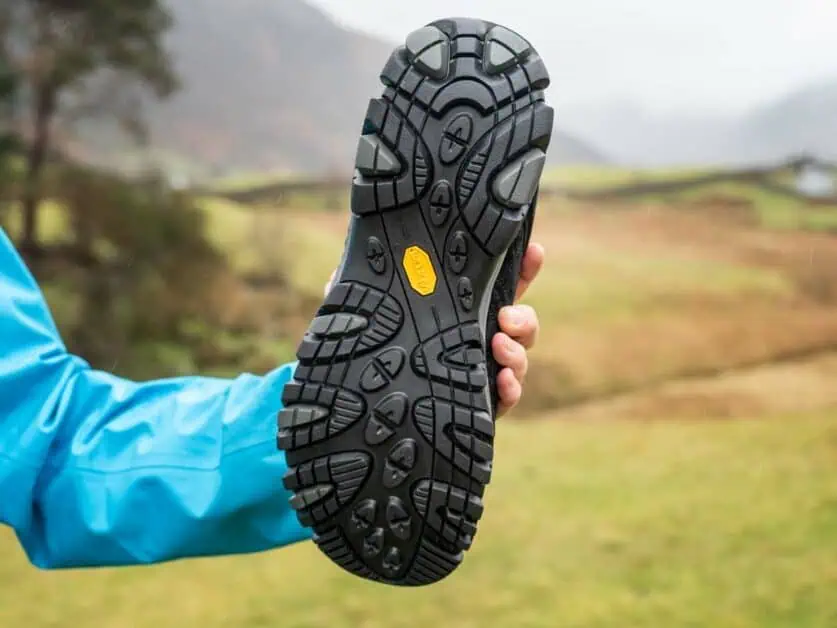
Breathability
Breathability varies from shoe to shoe, with some making use of synthetic systems and materials that offer greater breathability than others. Generally, you will experience greater breathability in a hiking shoe that isn’t waterproof, but that isn’t always the case.
We test breathability in a number of settings and extremes, from really hot summer days where you can expect your feet to get really sweaty all the way through to very rainy conditions where you might expect to experience sweating too. We’re looking for how this impacts longer term wear and if this leads to any blistering, discomfort or sore spots on the feet. Oh, and wet socks!
Ankle Support
Of course, hiking shoes don’t give the same level of ankle support that you can expect from a more traditional hiking boot. This is purely down to the fact that there isn’t really much provided around the ankle. That said, there are also various sock style designs on the market now, which provide more ankle support, some of which we’ve included in our reviews. When it comes to ankle support when testing, we’re looking at how well what is actually there helps against any rolls of the ankle, but also the freedom it provides and the steadiness and confidence you feel whilst wearing them.
Arch Support
Most hiking shoes come with a fairly standard arch support system, apart from a few brands who specifically look at a more orthopedic style fit (Hoka, for example, offer shoes in fits that are recommended by some orthopedic doctors). The general thing we test when it comes to arch support is how the shoe feels to wear for longer periods, is there any tiredness or fatigue, and does the specific fit of the arch make a difference there?
Fit
Fit is a really individual thing when it comes to hiking shoes – as we all have quite different fits and feels with our feet. Like many other shoes, hiking shoes are sometimes offered in a wider fit. However, much of the time, hiking shoes are offered in a standard fit, which can sometimes be a true standard, and can sometimes run narrower. We make a point of assessing how the various hiking shoes we’ve tested feel on a variety of width feet for longer periods of time. The fit is probably one of the most crucial aspects of a hiking shoe, so you need to get this right. We also rank for what the various brands return policies are, and also point out which shoes are offered in a wider or narrower fit.
Materials
Whilst it can be overwhelming looking at the various different materials offered for hiking shoes, it really only boils down to one thing – how does it fair on the trail? When taking into consideration materials in our tests, we’re looking for how well the various materials durability weighs out. We’re looking at how well the waterproofing works, if there are any snag points, any rigid areas which don’t fit right and how comfortable, light and robust they are over extended wear.
Appearance
Appearance is quite a divisive thing when it comes to hiking shoes – similar to people’s taste in fashion, hiking footwear is no different. You might be someone who cares a great deal how their hiking shoes look, you might also not. We try to be as objective as possible when it comes to the appearance of the hiking shoes we recommend to you – because our personal taste won’t exactly be yours. We just try to make you aware of anything that may get in the way with your hiking shoes, and actually cause problems where we don’t think they should.
Durability
Of course, no shoe is going to last forever, and if you’re hitting the trail a lot, then of course they will not last as long as a hiker who gets out less frequently. Aside from this, we are testing for how well made each shoe is, how the materials used could affect durability and if any durability concerns come up quickly. We test the shoes we recommend for as long as possible to allow us to feel confident in commenting on each shoe’s durability.
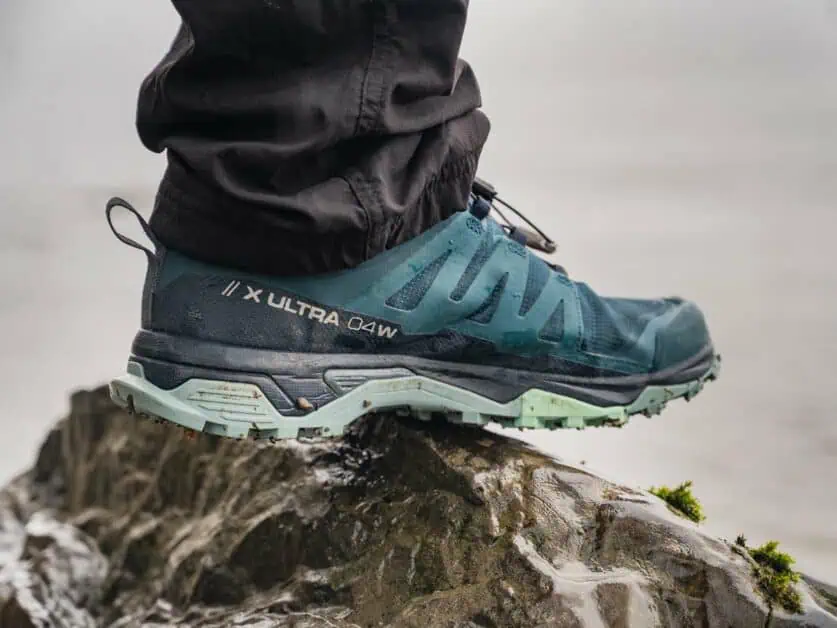
Sustainability
We do our research to find out what each brand is doing to encourage and take on more sustainable production practices and sourcing their materials.
We’re also looking at how the durability of the hiking shoes recommended affects their longevity – as buying less is one of the best ways we can have an impact on sustainability.
Water Resistance
Not every hiking shoe is water resistant, waterproof or water repellent, in fact some of the more fast and light shoes on the market cut out most of their waterproof nature in order to save weight and opt for more lightweight mesh fabrics. When testing waterproofing, we fully understand each brand’s claims before testing, and test to see if the shoe actually lives up to what it says it is supposed to be. For more on this, we’d recommend reading our article on the differences between waterproof, water resistant and water repellent.
Weight
Weight is quite an important testing metric for us – as the weight you have on your feet can lead to fatigue on the trail, especially with a heavier load to carry. When testing and making our recommendations, we are looking at how the shoes make use of different fabrics to create their lightweight feel (or not so lightweight feel) and how this actually feels after a long time on the trail. We also look at weight with durability in mind too, as a lightweight shoe is brilliant, but if it isn’t going to stand the test of time, it’s maybe not the best solution!
Insoles
Most hiking shoes come with a fairly standard insole, so we’re testing to see if this insole helps at all or takes away from the comfort you can expect to find in your hiking shoe. We also investigate if specific concern insoles are available from the manufacturer, or if this is needed for general wear.
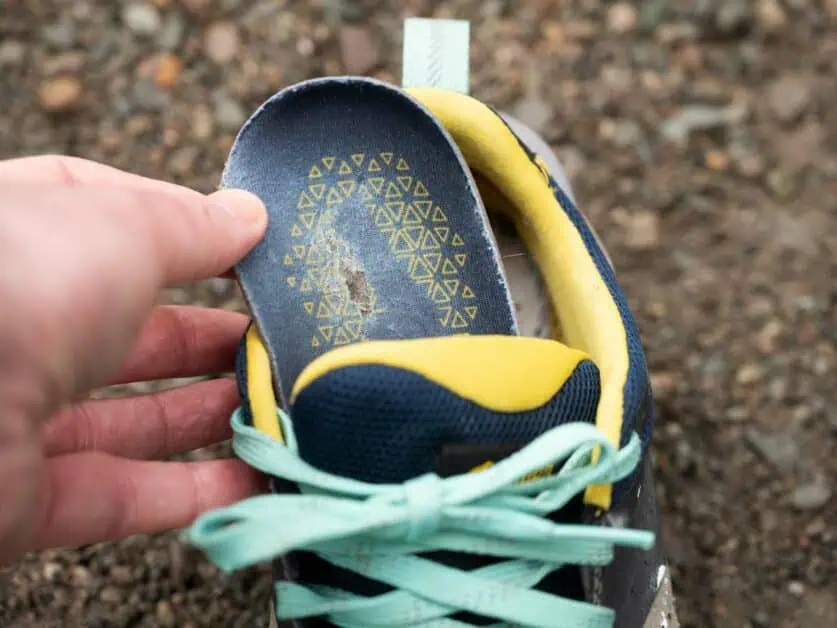
Break-in Period
A long break in period can be a real bore when it comes to hiking shoes – the idea that you might not really be able to wear them for a while can scupper your plans. We do a lot of our testing around how quickly the shoes are trail ready – and really trail ready. It’s one thing to feel they are ready straight away, but if you aren’t confident in it, wear them for a long trail and then end up getting blisters, that can be the difference between completing a hike or not.
Lacing System
There are various lacing systems available now – from standard systems to BOA style closures, elastic lacing etc., each one has its own strong point (and weakness too). Particularly when it comes to BOA fastenings, we like to consider and test how this feels to operate on the trail in colder conditions – sometimes the laces on these can be a lot thinner and the feeling of something cutting into your hands when you are cold isn’t the nicest! We also look for how well the laces can be adjusted for the perfect, and very individual fit and how that affects the overall user experience of the hiking shoe.
Toe Protection
Toe protection can really help against bumps and knocks on the trail that otherwise could lead to toe injuries. Some hiking shoes have better protection than others – ones that favor a lot of mesh and a fast and light approach, may be less protective than, say, an approach shoe. We tend to try and take a holistic approach when it comes to testing toe protection and look at the intended use of a shoe before rating it to give you a real world understanding of just what you’ll be getting if you purchase that product.
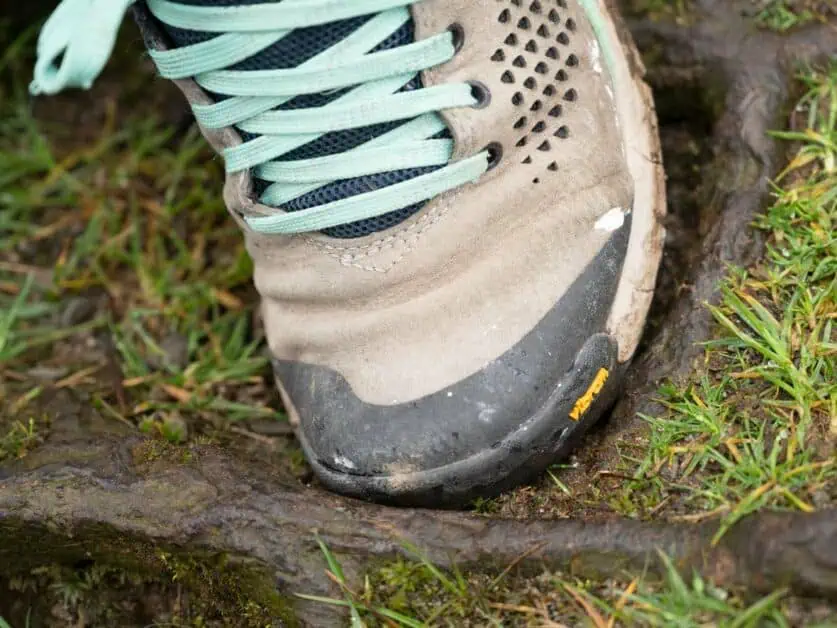
Conclusion
When testing hiking shoes, we test in the outdoors – there is no better place to test than by doing the things we love! There is simply no better way than to see any potential problems that might arise in the environments you’re going to wear them. As we’ve said various times, we always take a holistic approach and look at what the shoe is intended for, rather than seeing it in a different way and marking it down. We’re geeky about what we recommend and the shoes you see on in our reviews have had lots of miles of testing poured into them!
Disclaimer: This article contains Affiliate Links. You won’t pay any more for buying through these links, but we may receive a commission from any purchases made through them. As an Amazon Associate, I earn from qualifying purchases. If you choose to support us by buying through our links, we thank you as it helps us to continue providing the resources we do to help you enjoy the outdoors more!
